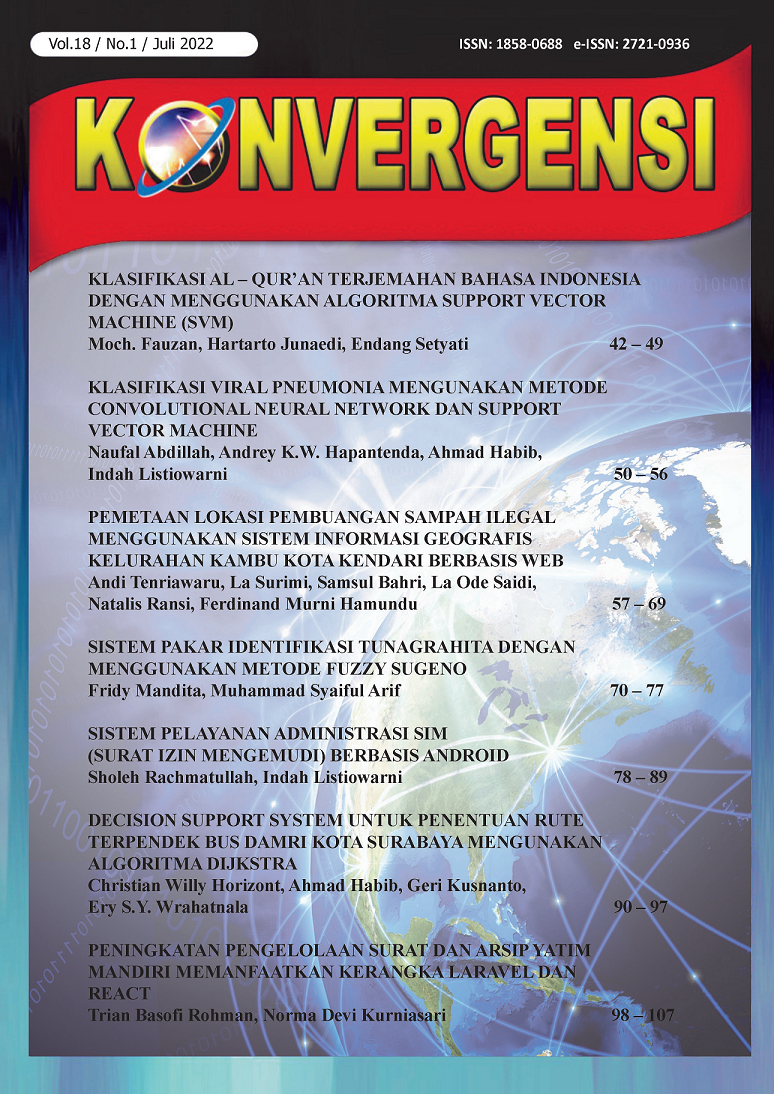DECISION SUPPORT SYSTEM UNTUK PENENTUAN RUTE TERPENDEK BUS DAMRI KOTA SURABAYA MENGUNAKAN ALGORITMA DIJKSTRA
Abstract
The growth of information technology especially internet and web-based application can make information access of Damri bus route in Surabaya easier that will be developed with PHP, HTML, Javascript, and MySQL there’re also tools needed are Laragon, VSCode, Web-Browser, and Navicat. The method used in this application development is Dijkstra algorithm, These algorithm used for calculate closest route from one bus-stop to another. These web-based application provide information of shortest bus routes and also help determining bus which new passengers should take to get to some place.
Keywords: Decision Support System, bus damri, dijkstra, closest route
ABSTRAK
Perkembangan di bidang teknologi informasi khususnya teknologi internet dan aplikasi berbasis web dapat mempermudah dalam mengakses informasi rute Damri di kota Surabaya yang akan dibuat menggunakan PHP, HTML, Javascript dan MySQL adapun alat yang dibutuhkan ialah Laragon, VSCode, Web-Browser, dan Navicat. Metodologi yang digunakan dalam pembuatan aplikasi ini adalah algoritma Dijkstra, Algoritma ini dipakai untuk menghitung jarak terdekat dari suatu halte ke halte lainnya. Aplikasi berbasis web ini akan memberikan informasi berupa rute bus terpendek serta akan membantu menentukan bus yang harus dinaiki calon penumpang untuk mencapai ke suatu tujuan.
Kata Kunci: Sistem pendukung keputusan, bus damri, dijkstra, rute terdekat
Downloads
References
Nurdin, Syafrizal, Elfindri, and Syofyardi, “Transportation cost and regional trade perspective: Evidence of Indonesia logistic performance,” Opcion, vol. 35, no. Special Issue 21, 2019.
J. Carneiro, P. Alves, G. Marreiros, and P. Novais, “Group decision support systems for current times: Overcoming the challenges of dispersed group decision-making,” Neurocomputing, vol. 423, 2021.
Rifqi Hanan Riokka and S. Zainab, “Mapping of Restaurant Distribution in The Wonokromo District Area Using Google Platform,” CI-TECH, vol. 2, no. 01, 2021.
A. Setiawan, L. Y. Hendrati, and Y. A. Mirasa, “The Mapping and Analysis of Diphteria Cases in Surabaya (2017-2018),” Jurnal Biometrika dan Kependudukan, vol. 10, no. 1, 2021.
L. Aggarwal, P. Goswami, and S. Sachdeva, “Multi-criterion Intelligent Decision Support system for COVID-19,” Applied Soft Computing, vol. 101, 2021.
M. H. Firmansyah, “Implementation of Occupational Safety and Healthy Risk Management in Islamic Hospital Surabaya A. Yani,” Medical and Health Science Journal, vol. 5, no. 2, 2021.
A. A. A. Gassar and S. H. Cha, “Review of geographic information systems-based rooftop solar photovoltaic potential estimation approaches at urban scales,” Applied Energy, vol. 291, 2021.
M. Klum, T. Schenck, A. Pielmus, T. Tigges, and R. Orglmeister, “Short distance impedance pneumography,” Current Directions in Biomedical Engineering, vol. 4, no. 1, 2018.
D. D. Zhu and J. Q. Sun, “A New Algorithm Based on Dijkstra for Vehicle Path Planning Considering Intersection Attribute,” IEEE Access, vol. 9, 2021.
G. Sun and J. Zacharias, “Can bicycle relieve overcrowded metro? Managing short-distance travel in Beijing,” Sustainable Cities and Society, vol. 35, 2017.
M. Vallet-Regi and A. J. Salinas, “Role of the short distance order in glass reactivity,” Materials, vol. 11, no. 3. 2018.
Y. L. Zheng et al., “Exploring a new adaptive routing based on the dijkstra algorithm in optical networks-on-chip,” Micromachines, vol. 12, no. 1, 2021.
M. Akram, A. Habib, and J. C. R. Alcantud, “An optimization study based on Dijkstra algorithm for a network with trapezoidal picture fuzzy numbers,” Neural Computing and Applications, vol. 33, no. 4, 2021.
R. B. Velasco, I. Carpanese, R. Interian, O. C. G. Paulo Neto, and C. C. Ribeiro, “A decision support system for fraud detection in public procurement,” International Transactions in Operational Research, vol. 28, no. 1, 2021.
Y. Yun, D. Ma, and M. Yang, “Human–computer interaction-based Decision Support System with Applications in Data Mining,” Future Generation Computer Systems, vol. 114, 2021.
X. Ren, S. Wu, Z. Xing, R. Xu, W. Cai, and Z. Lei, “Behavioral responses of western flower thrips (Frankliniella occidentalis) to visual and olfactory cues at short distances,” Insects, vol. 11, no. 3, 2020.
A. Habib and A. Kartika W. H., “Development of an Online Sales Information System for SMEs Using Incremental Methods,” INTENSIF: Jurnal Ilmiah Penelitian dan Penerapan Teknologi Sistem Informasi, vol. 4, no. 1, pp. 51–62, 2020.
A. Hajar, I. Nabawi, L. Kartikawati, F. R. Yudana, S. Budi, and N. Prasetiyantara, “Pengolahan Data Spasial-Geolocation Untuk Menghitung Jarak 2 Titik,” Creative Information Technology Journal, vol. 8, no. 1, 2021.
A. Habib, M. A. Jani, D. A. Pratama, and E. Ronando, “Development of archives management information system with RFID and SMS gateway,” International Journal of Psychosocial Rehabilitation, vol. 24, no. 4, pp. 5227–5243, 2020.
A. Habib, A. Darwanto, E. Ronando, and Slamet, “Pump control system using microcontroller and Short Message Service (SMS) gateway for flood prevention,” Springer Proceedings in Physics, vol. 193, no. January, pp. 607–621, 2017.
Authors whose manuscript is published will approve the following provisions:
- The right to publication of all journal material published on the Konvergensi Teknologi Informasi & Komunikasi website is held by the editorial board with the author's knowledge (moral rights remain the property of the author).
- The formal legal provisions for access to digital articles of this electronic journal are subject to the terms of the Creative Commons Attribution-ShareAlike (CC BY-SA) license, which means Konvergensi Teknologi Informasi & Komunikasi reserves the right to store, modify the format, administer in database, maintain and publish articles without requesting permission from the Author as long as it keeps the Author's name as the owner of Copyright.
- Printed and electronic published manuscripts are open access for educational, research and library purposes. In addition to these objectives, the editorial board shall not be liable for violations of copyright law.




